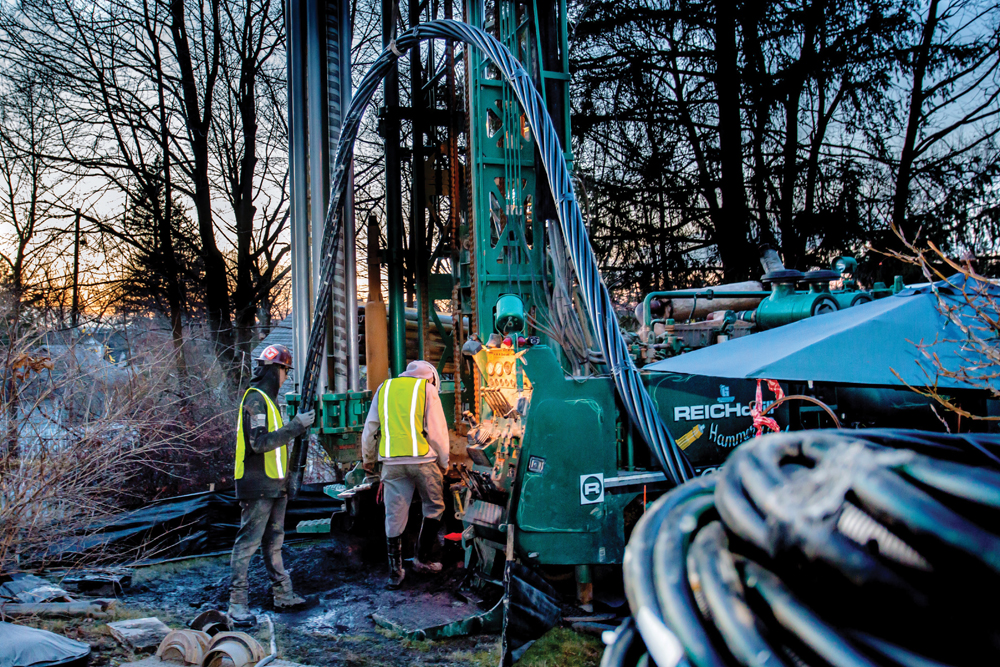From the Ground Up
Employment Opportunities Within the Geothermal Sector
By John Ciovacco | Winter 2021 | Clean Power Guide
The geothermal field offers a variety of occupations and roles in the installation, design, and maintenance of geothermal systems. Let’s start with installation. There are two main components to a geothermal heat pump installation: the inside work and the outside work. The inside work involves the installation of the heat pump itself, done by mechanical, electrical, and plumbing engineers, project managers, and technicians. The outside work makes a thermal connection to the ground, done by drillers and excavators with piping support from HVAC (heating, ventilation, and air conditioning) technicians.
The inside work is very similar in design and installation to an air conditioning system, so it is not difficult to train designers (often engineers) and installers (technicians) that are presently involved in HVAC to design and install the inside components of a geothermal heat pump system. The outside work requires specialized design and installation procedures that are less common, so it requires a bit more training and experience to get both the design and installation right. Some HVAC designers and/or contractors learn this new “ground coupling” skill and can put both pieces together for projects.
Several specific trainings are offered by the International Ground Source Heat Pump Association (IGSHPA). The most common is a three-day course with a written test to become an IGSHPA-accredited installer. For design professionals, IGSHPA and the Association of Energy Engineers (AEE) offer a 40-hour course with a more rigorous test and required design experience to become an IGSHPA/AEE-certified geothermal designer. A relatively new certification to help encourage good installation practices is a 20-hour course with a test and required field experience to become an IGSHPA-certified geothermal inspector. Aside from these industry-specific courses, college engineering courses and trade school coursework in HVAC are the foundation for much of what needs to be learned to design and install geothermal systems.
Building electrification is a well-defined trend, which will drive increases in all types of heat pump installations, including geothermal heat pump systems. New York State’s energy and environmental policy, supported by 2019 passage of the Climate Leadership and Community Protection Act, anticipates that heat pumps will make up over 90 percent of the HVAC equipment sales in the state by 2050. This is further supported by increasing utility rebate levels and the continuation of federal tax credits for geothermal heat pump systems. While we have a good stable of design professionals and HVAC contractors to do the inside work, the workforce supporting the outside systems will need to increase significantly to support the demand for the most efficient heat pumps systems available today. Specifically, drilling capacity today to install vertical heat exchangers will need to grow by an order of magnitude to keep pace with demand projections for new construction and existing building conversions.
Traditionally, geothermal heat pump systems have been installed in suburban areas by small companies, many with fewer than 10 employees. These companies often struggle to maintain staffing, especially with today’s tight job market, and don’t often have diversity, equity, or inclusion policies beyond legal requirements. As we see more large geothermal projects taking place, larger HVAC contractors are engaged and have more sophisticated hiring practices, often with emphasis on diversity, in order to meet bidding requirements sometimes found on larger projects.
Compensation is quite good for even entry level jobs involved in the design and installation of geothermal heat pump systems. Entry level HVAC technicians commonly start above $15 per hour, and experienced senior level technicians can easily make over $30/hour. Skilled drillers and excavators are also well paid. Many large geothermal projects may use union labor or have a prevailing wage requirement, which commands a higher wage for workers.
Installing geothermal systems is just plain old hard work at times! Heat pumps are heavy and need to be moved and installed in all sorts of places in buildings. Heat pumps are high-pressure refrigeration systems powered by electricity and require training and appropriate safety equipment to work on safely. There are inherent risks when working with heavy equipment, like drilling and excavation, which also are covered by OSHA safety standards and related training. If the hands-on aspects make you weak in the knees, there is also growth in jobs related to design, inspection, sales and marketing, finance, and management. As geothermal systems become more popular, there will also be an increase in landscaping to bring the grounds back to their original condition.
